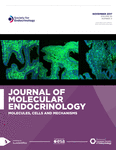Progesterone action in breast, uterine, and ovarian cancers
- Hematology, Oncology, and Transplantation Division
1Departments of Medicine
2Pharmacology, Masonic Cancer Center, University of Minnesota, Delivery Code 2812, Cancer Cardiology Research Building, 2231 6th Street SE, Minneapolis, Minnesota 55455, USA
3Division of Physiology and Growth, Department of Animal Science, University of Minnesota, Minneapolis, Minnesota 55108, USA
- Correspondence should be addressed to C A Lange; Email: lange047{at}umn.edu
Abstract
Progesterone and progesterone receptors (PRs) are essential for the development and cyclical regulation of hormone-responsive tissues including the breast and reproductive tract. Altered functions of PR isoforms contribute to the pathogenesis of tumors that arise in these tissues. In the breast, progesterone acts in concert with estrogen to promote proliferative and pro-survival gene programs. In sharp contrast, progesterone inhibits estrogen-driven growth in the uterus and protects the ovary from neoplastic transformation. Progesterone-dependent actions and associated biology in diverse tissues and tumors are mediated by two PR isoforms, PR-A and PR-B. These isoforms are subject to altered transcriptional activity or expression levels, differential crosstalk with growth factor signaling pathways, and distinct post-translational modifications and cofactor-binding partners. Herein, we summarize and discuss the recent literature focused on progesterone and PR isoform-specific actions in breast, uterine, and ovarian cancers. Understanding the complexity of context-dependent PR actions in these tissues is critical to developing new models that will allow us to advance our knowledge base with the goal of revealing novel and efficacious therapeutic regimens for these hormone-responsive diseases.
- progesterone
- progestin
- progesterone receptor
- isoforms
- breast cancer
- endometrial cancer
- uterine
- ovarian cancer
- Revision received 15 December 2014
- Accepted 12 January 2015
- Made available online as an Accepted Preprint 13 January 2015
- © 2015 Society for Endocrinology











